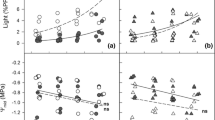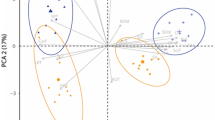Abstract
Species in high-rainfall regions have two major alternative approaches to quickly drain off water, i.e., increasing leaf inclination angles relative to the horizontal plane, or developing long leaf drip tips. We hypothesized that shade-adapted species will have more pronounced leaf drip tips but not greater inclination angles (which can reduce the ability to intercept light) compared to sun-adapted species and that length of leaf drip tips will be negatively correlated with photosynthetic capacity [characterized by light-saturated net photosynthetic rates (A max), associated light compensation points (LCP), and light saturation points (LSP)]. We tested this hypothesis by measuring morphological and physiological traits that are associated with light-interception and water shedding for seven shade-adapted shrub species, ten sun-adapted understory shrub species, and 15 sun-adapted tree species in a subtropical Chinese rainforest, where mean annual precipitation is around 1,600 mm. Shade-adapted understory species had lower LMA, A max, LSP, and LCP compared to understory or canopy sun-adapted species; their leaf and twig inclination angles were significantly smaller and leaf drip tips were significantly longer than those in sun-adapted species. This suggests that shade-adapted understory species tend to develop pronounced leaf drip tips but not large leaf inclination angles to shed water. The length of leaf drip tips was negatively correlated with leaf inclination angles and photosynthetic capacity. These relationships were consistent between ordinary regression and phylogenetic generalized least squares analyses. Our study illustrates the trade-offs between light interception and leaf water shedding and indicates that length of leaf drip tips can be used as an indicator of adaptation to shady conditions and overall photosynthetic performance of shrub species in subtropical rainforests.




Similar content being viewed by others
References
Boardman NK (1977) Comparative photosynthesis of sun and shade plants. Annu Rev Plant Physiol 28:355–377
Bonsall MB, Jansen VAA, Hassell MP (2004) Life history trade-offs assemble ecological guilds. Science 306:111
Burd M (2007) Adaptive function of drip tips: a test of the epiphyll hypothesis in Psychotria marginata and Faramea occidentalis (Rubiaceae). J Trop Ecol 23:445–449
Chazdon RL (1988) Sunflecks and their importance to forest understorey plants. Adv Ecol Res 18:1–63
Coley PD, Kursar TA (1996) Causes and consequences of epiphyll colonization. In: Mulkey SS, Chazdon RL, Smith AP (eds) Tropical forest plant ecophysiology. Chapman and Hall, New York, pp 337–362
Crockford R, Richardson D (2000) Partitioning of rainfall into throughfall, stemflow and interception: effect of forest type, ground cover and climate. Hydrol Process 14:2903–2920
Dean JM, Smith AP (1978) Behavioral and morphological adaptations of a tropical plant to high rainfall. Biotropica 10:152–154
Ding SY, Song YC (1999) The comparison of photosynthesis physiecology of evergreen broad-leaved forest of Tiantong National Forest Park in Zhejiang province, China (in Chinese). Acta Ecol Sin 19:318–323
Edmisten J (1970) Some autecological studies of Ormosia krugii. In: Odum HT, Pidgeon FR (eds) A tropical rain forest. Atomic energy commission, Washington, DC, pp 291–298
Farji-Brener AG, Valverde O, Paolini L, de los Angeles La Torre M, Quintero E, Bonaccorso E, Arnedo L, Villalobos R (2002) Acumen function in leaves and its vertical distribution in a tropical rain forest of Costa Rica. Rev Biol Trop 50:561–567
Felsenstein J (1985) Phylogenies and the comparative method. Am Nat 125:1–15
Freckleton R, Harvey P, Pagel M (2002) Phylogenetic analysis and comparative data: a test and review of evidence. Am Nat 160:712–726
Ivey CT, De Silva N (2001) A test of the function of drip tips. Biotropica 33:188–191
Kitajima K (1994) Relative importance of photosynthetic traits and allocation patterns as correlates of seedling shade tolerance of 13 tropical trees. Oecologia 98:419–428
Kubiske ME, Abrams MD, Mostoller SA (1996) Stomatal and nonstomatal limitations of photosynthesis in relation to the drought and shade tolerance of tree species in open and understory environments. Trees 11:76–82
Leigh EG (1975) Structure and climate in tropical rain forest. Annu Rev Ecol Evol Syst 6:67–86
Lewandowska M, Jarvis P (1977) Changes in chlorophyll and carotenoid content, specific leaf area and dry weight fraction in Sitka spruce, in response to shading and season. New Phytol 79:247–256
Lightbody JP (1985) Distribution of leaf shapes of Piper sp. in a tropical cloud forest: evidence for the role of drip-tips. Biotropica 17:339–342
Malhado ACM et al (2012) Drip-tips are associated with intensity of precipitation in the amazon rain forest. Biotropica 44:728–737
Mc Millen GG, Mc Clendon JH (1979) Leaf angle: an adaptive feature of sun and shade leaves. Bot Gaz 140:437–442
Meir P, Kruijt B, Broadmeadow M, Barbosa E, Kull O, Carswell F, Nobre A, Jarvis PG (2002) Acclimation of photosynthetic capacity to irradiance in tree canopies in relation to leaf nitrogen concentration and leaf mass per unit area. Plant Cell Environ 25:343–357
Niinemets Ü, Cescatti A, Rodeghiero M, Tosens T (2006) Complex adjustments of photosynthetic potentials and internal diffusion conductance to current and previous light availabilities and leaf age in Mediterranean evergreen species Quercus ilex. Plant Cell Environ 29:1159–1178
Niinemets Ü, Portsmuth A, Tobias M (2007) Leaf shape and venation pattern alter the support investments within leaf lamina in temperate species: a neglected source of leaf physiological differentiation? Funct Ecol 21:28–40
Niklas KJ (1988) The role of phyllotactic pattern as a “developmental constraint” on the interception of light by leaf surfaces. Evolution 42:1–16
Niklas KJ (1998) Light harvesting “fitness landscapes” for vertical shoots with different phyllotactic patterns. In: Jean RV, Barabé D (eds) Symmetry in plants. World Scientific, Singapore, pp 759–773
Paradis E, Claude J, Strimmer K (2004) APE: analyses of phylogenetics and evolution in R language. Bioinformatics 20:289–290
Pearcy R (1987) Photosynthetic gas exchange responses of Australian tropical forest trees in canopy, gap and understory micro-environments. Funct Ecol 1:169–178
R Development Core Team (2011) R: a language and environment for statistical computing. R Foundation for Statistical Computing, Vienna
Rebelo CF, Williamson GB (1996) Driptips vis-à-vis soil types in central Amazonia. Biotropica 28:159–163
Richards PW (1996) The tropical rain forest: an ecological study, 2nd edn. Cambridge University Press, Cambridge
Rijkers T, Pons TL, Bongers F (2000) The effect of tree height and light availability on photosynthetic leaf traits of four neotropical species differing in shade tolerance. Funct Ecol 14:77–86
SAS (2003) JMP 5.0.1. SAS Institute, Cary, NC
Smith T, Huston M (1989) A theory of the spatial and temporal dynamics of plant communities. Vegetation 83:49–69
Song YC, Wang XR (1995) Vegetation and flora of Tiantong National Forest Park in Zhengjiang, China. Shanghai Science & Technology Press, Shanghai
Valiente-Banuet A, Verdú M, Valladares F, García-Fayos P (2010) Functional and evolutionary correlations of steep leaf angles in the mexical shrubland. Oecologica 163:25–33
Valladares F, Pearcy RW (1998) The functional ecology of shoot architecture in sun and shade plants of Heteromeles arbutifolia M. Roem., a Californian chaparral shrub. Oecologia 114:1–10
Walters M, Field C (1987) Photosynthetic light acclimation in two rainforest Piper species with different ecological amplitudes. Oecologia 72:449–456
Wang XR (1993) The analysis of ecological characteristics of an evergreen, broad-leaved forest in Tiantong National Forest Park Zhejiang, east China (in Chinese). J Hubei Univ (Nat Sci) 15:301–306
Watling JR, Press MC, Quick WP (2000) Elevated CO2 induces biochemical and ultrastructural changes in leaves of the C4 cereal sorghum. Plant Physiol 123:1143–1152
Webb CO, Ackerly DD, Kembel SW (2008) Phylocom: software for the analysis of phylogenetic community structure and trait evolution. Bioinformatics 24:2098–2100
White PS (1983) Corner’s rules in eastern deciduous trees: allometry and its implications for the adaptive architecture of trees. Bull Torrey Bot Club 110:203–212
White CR, Blackburn TM, Seymour RS (2009) Phylogenetically informed analysis of the allometry of mammalian basal metabolic rate supports neither geometric nor quarter-power scaling. Evolution 63:2658–2667
Whitmore TC (1990) An introduction to tropical rain forests. Clarendon Press, Oxford
Williamson GB (1981) Driptips and splash erosion. Biotropica 13:228–231
Yates MJ, Anthony Verboom G, Rebelo AG, Cramer MD (2010) Ecophysiological significance of leaf size variation in Proteaceae from the Cape Floristic Region. Funct Ecol 24:485–492
Acknowledgments
We thank Zhuoyao Dong, Xincheng Li, Jianqiang Tang, Yangjie Xia for field assistance and the staff of Tiantong National Forest Park for permitting this study to be conducted. This study was funded by the National Science Foundation of China (31170382) and PCSIRT (IRT1020).
Author information
Authors and Affiliations
Corresponding author
Additional information
Communicated by Fernando Valladares.
Electronic supplementary material
Below is the link to the electronic supplementary material.
Rights and permissions
About this article
Cite this article
Meng, F., Cao, R., Yang, D. et al. Trade-offs between light interception and leaf water shedding: a comparison of shade- and sun-adapted species in a subtropical rainforest. Oecologia 174, 13–22 (2014). https://doi.org/10.1007/s00442-013-2746-0
Received:
Accepted:
Published:
Issue Date:
DOI: https://doi.org/10.1007/s00442-013-2746-0




